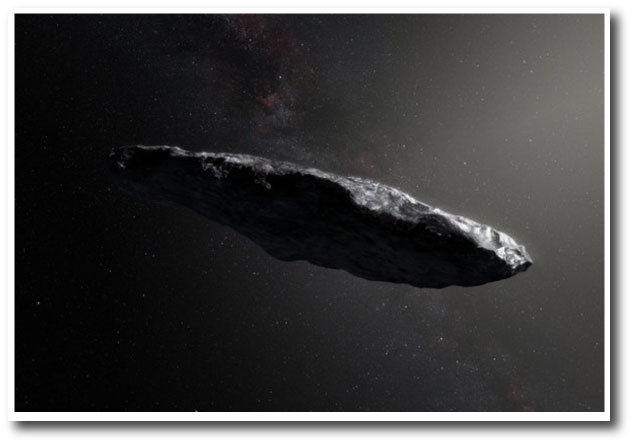‘Oumuamua. Up close and alongside, in the vastness of interstellar space, its hurtling bulk imparts no sense of motion as it turns imperceptibly on its axis, blotting out the stars.
For a hundred years, the point-like Sun grew steadily brighter against its frigid airless horizons. First came light, then warmth, and finally searing illumination of the tarry reddish expanse, blistering sluggishly beneath a September Noon far more intense than any summer of Earth.
`Oumuamua is departing the solar system as rapidly as it arrived, heading outward at a current rate of 2.5 million miles a day. Our tiny chance of sending a probe to catch it diminishes with each lagging tick of inactivity. Nonetheless, world-wide interest is mounting, in part as a consequence of two new articles reporting detailed observations. The first, by Jewitt et al. was posted to arXiv last week, while the second, by Meech et al. (which independently comes largely to the same overall conclusions), appeared in Nature earlier this week. Nature being Nature, the Meech et al. article was accompanied by a media push, spearheaded by an extraordinary piece of space art.
Maybe it’s press release fatigue from one “habitable” world after another — a monotony of warm suns glinting off imaginary oceans — that makes this image so arresting.
The observational facts remain stark and limited. `Oumuamua’s double-peaked light curve suggests that it has a large aspect ratio, perhaps as high as 10:1. Assuming that it’s a poor reflector, it’s several hundred meters on its long axis. Its overall color is reddish. It has to have physical strength, or its 7-hour rotation period would be enough to overcome its negligible self-gravity and tear it apart. Most alarmingly, it shows no sign of a coma. At most, less than a sugar cube’s worth of cometary dust per second was emanating from it as it tore through the inner solar system. (As a matter of fact, ‘Oumuamua as observed is entirely consistent with Tintin’s rocket.)
For more on ‘Oumuamua, I have a blog post up at Scientific American.


